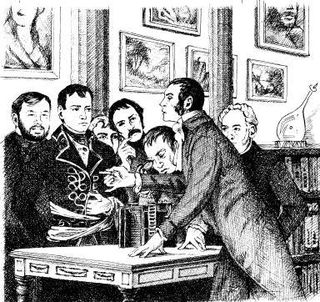Squeezing More Life Out of Your Notebook's Battery Part I
OEM spin aside, notebook battery lives just are not up to what consumers and business want. Industry group Mobile PC EBLWG says laptops that run eight hours on a charge will be available by 2008. But how do they expect to pull the feat off and what can you do in the meantime to squeeze more life out of your notebook's battery? Keywords
A Brief Summation Of Battery History And Battery Types
In 1800, with his discovery of so-called "voltaic elements," the Italian scientist Alessandro Volta laid the groundwork for the use of batteries to deliver electrical energy.

Volta in an experiment at the French National Institute in November, 1800. He discovered the voltaic element, a non-rechargeable battery. This is the original ancestor of the alkaline battery.
In 1859, the French scientist Gaston Plante discovered the lead-acid battery, the first rechargeable battery type, also known as an accumulator. Non-rechargeable batteries like voltaic cells are known as primary cells, while rechargeables fall under the secondary cell category. Batteries also incorporate two electrodes, which transfer electrons through an electrolyte. Various battery types may be distinguished primarily by the types of materials used for their electrodes and the composition of the electrolyte. A secondary method for distinguishing among batteries is their physical shape. The most often used designations in this category include cylindrical or button cells, along with the so-called prismatic cells most often found in mobile telephones.
The Rechargeable NiCd (nickel-cadmium) Battery
A chemist named Junger developed the first alkaline battery in 1899. He used nickel for the positive electrode, and cadmium for the negative electrode. A potassium hydroxide solution served as its electrolyte. The alkaline nature of that electrolyte also provided the inspiration for this battery's name or type designation. Nearly 50 years later (1946) Neumann developed the first sealed NiCad battery.
Until the early 1990s the NiCd (pronounced "nie cad" where "nie" rhymes with "die") battery remained the most widely used of rechargeable battery for consumer products. But in the notebook arena, this kind of battery is no longer used today. That's because the intervening years have witnessed the development of newer, more powerful types of batteries.
Sign up to get the BEST of Tom's Guide direct to your inbox.
Get instant access to breaking news, the hottest reviews, great deals and helpful tips.
Current page: A Brief Summation Of Battery History And Battery Types
Prev Page Intel Claims That The Display And Chipset Consume More Energy Than The CPU Next Page Higher Energy Density: The Rechargeable Nickel Metal Hydride Battery-
denist44 As far as I am concerned ,the temperature, amount of usage and nature of usage contributed signfically to the laptop battery lifespan.On the other hand, You can lower screen brightness, reduce CPU processing speed, chance cooling method, and other settings available on your laptop to prolong your battery life.HP Probook 4410s battery battery for HP Probook 4410sReply -
denist44 As far as I am concerned ,the temperature, amount of usage and nature of usage contributed signfically to the laptop battery lifespan.On the other hand, You can lower screen brightness, reduce CPU processing speed, chance cooling method, and other settings available on your laptop to prolong your battery life.Reply
